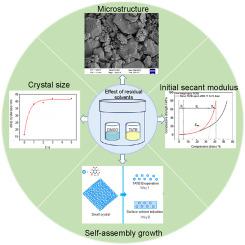Energetic Materials Frontiers Pub Date : 2023-03-22 , DOI: 10.1016/j.enmf.2023.03.004 Nan-nan Lin , Chun Xu , He-liang Sui , Feng Wang , Zheng Gong , Jie Sun , Xin Ju

|
The stability of nano-TATB in an environment of long-term storage or service is currently one concern since it will affect the reliability of weapon systems. To explore the effects of the residual dimethyl sulfoxide (DMSO) solvent generated during synthesis on the storage performance of nano-TATB, this study proposed a new strategy that utilized solvent atmosphere induction to simulate the effects of residual solvents for the first time and quantified the residual solvents using the equilibrium adsorption capacity (Qe) obtained from the pseudo-first-order adsorption kinetic model. Moreover, this study investigated the storage performance of nano-TATB in the DMSO atmosphere using techniques of scanning electron microscopy (SEM), X-ray diffraction (XRD), Raman spectroscopy (Raman), and infrared (IR) spectroscopy. The results show that the residual DMSO can induce nano-TATB growth more significantly than stimuli in a hot and humid environment. After aging at 60 °C for 1 d in the DMSO atmosphere, a large number of particles with relatively a regular shape and a particle size of about 1 μm were generated in the DMSO atmosphere, with a Qe of DMSO of (1.045 ± 0.026) mg·g−1. After aging for 5 d, some nano-TATB particles grew and had a particle size of up to 5–6 μm, and the average density and cohesive strength of nano-TATB greatly increased. As shown by the analysis of the growth mechanism of nano-TATB in the DMSO atmosphere based on the above experimental results, the main reason for the self-assembly of nano-TATB is the surface DMSO induction caused by the interactions between nano-TATB and DMSO molecules. These results show that the key to improving the storage stability of nano-TATB is to reduce the content of residual solvents.
中文翻译:

残留二甲基亚砜对纳米TATB贮存性能的影响
纳米TATB在长期储存或服役环境中的稳定性是目前关注的一个问题,因为它会影响武器系统的可靠性。为了探讨合成过程中产生的残留二甲基亚砜(DMSO)溶剂对纳米TATB储存性能的影响,本研究首次提出了一种利用溶剂气氛诱导来模拟残留溶剂影响的新策略,并量化了使用平衡吸附容量 ( Q e) 从准一级吸附动力学模型获得。此外,本研究使用扫描电子显微镜 (SEM)、X 射线衍射 (XRD)、拉曼光谱 (Raman) 和红外 (IR) 光谱技术研究了纳米 TATB 在 DMSO 气氛中的存储性能。结果表明,在湿热环境中,残留的 DMSO 比刺激更能诱导纳米 TATB 的生长。在DMSO气氛中60℃老化1d后,在DMSO气氛中产生大量形状较规则、粒径约为1μm的颗粒,DMSO的Q e为( 1.045 ± 0.026) 毫克·克−1. 老化 5 d 后,部分纳米 TATB 颗粒长大,粒径可达 5~6 μm,纳米 TATB 的平均密度和内聚强度大大增加。基于上述实验结果分析纳米TATB在DMSO气氛中的生长机理表明,纳米TATB自组装的主要原因是纳米TATB与纳米TATB相互作用引起的表面DMSO诱导。二甲基亚砜分子。这些结果表明,提高纳米TATB储存稳定性的关键是降低残留溶剂的含量。



























 京公网安备 11010802027423号
京公网安备 11010802027423号